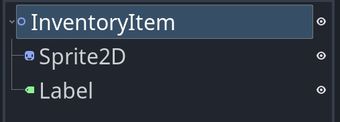Property proxying in Godot
Mon Oct 09 2023
Probably, a typical scenario in Godot is where you have a scene that consists of multiple nodes of various kinds with the intention of reuse.
For our example, let us use a theoretical scene that has a Sprite2D and a Label as their children. We could use that to display a list of inventory items in our game.

Probably the two main things you would want to change are the label text and the texture of the sprite.
One way you could reuse this scene is with inherited scenes (Scene → New Inherited Scene), but then you would be creating an inherited scene for every inventory item, and, especially in a game with a lot of items, that would be a lot of time better spent elsewhere, and it would also complicate your scripts since for every inventory item you would have a separate preload() or load() call each scene and so on.
Another way could be to work with "Editable Children" of the InventoryItem instances from a main inventory scene, but I also don't think that this approach is very good since you expose the "internals" of your reusable scene to a scene that should have no business seeing what's under the hood of your InventoryItem.
What we want to do is provide a clean interface to the consumers of our InventoryItem scene, so parent scenes know what they can change without breaking stuff. We will achieve that with property proxying, which is a quite common pattern. What that means is that we will combine GDScript exports with setters, and as a result, our InventoryItem will have properties that, upon change, will also update the properties of our sprite and label. This way, we will have a highly reusable and potentially limitlessly customizable scene without having to create inherited scenes or edit children of instantiated scenes.
How?
Lets start with the groundwork - attach a script to the InventoryItem node, pick "Object: Empty" as the template, and press "Create".
Write the following:
@tool
extends Node2D
@export var text: String:
set = set_text
@export var texture: Texture2D:
set = set_texture
func set_text(value: String) -> void:
pass
func set_texture(value: Texture2D) -> void:
passWe define two exported properties, meaning that we can not only change them from code but also assign them through the Godot inspector:

We use text of type String, since we will set the property text of our Label, and we use texture of type Texture2D since we will set the texture property of our Sprite2D. It isn't important that the property names match; I think it's just simpler to read and understand that way, but property names should be relevant to the purpose of the scene, so item_name instead of text and portrait instead of texture could work better.
We define two (for now, empty) setter functions for them. Setters allow us to run logic when a property is set.
Finally, a @tool keyword at the top tells the script to run in the editor, so we can instantly see the results of our properties being set.
Now, lets implement the setters themselves, which is the crucial part.
@onready var sprite: Sprite2D = $Sprite2D
@onready var label: Label = $Label
func set_text(value: String) -> void:
text = value
if not is_inside_tree():
await ready
label.text = value
func set_texture(value: Texture2D) -> void:
texture = value
if not is_inside_tree():
await ready
sprite.texture = valueFirst, we store references of our child nodes. The $ syntax is a nice syntax-sugarry way to fetch nodes by path, but if you plan on moving them around, I recommend using unique nodes so your script doesn't break if you decide to move the nodes into a container.
Both setters themselves are pretty much doing the same thing: they set the value of the property itself, wait until our node is ready and a part of the scene tree, so the references to the child nodes are set up and then set the property of the child. Already now, if you play around with the exported values, you can see the changes right away, as if you were editing the children directly:
And that's how our final script looks like in its entirety:
# inventory_item.gd
@tool
extends Node2D
@export var text: String:
set = set_text
@export var texture: Texture2D:
set = set_texture
@onready var sprite: Sprite2D = $Sprite2D
@onready var label: Label = $Label
func set_text(value: String) -> void:
text = value
if not is_inside_tree():
await ready
label.text = value
func set_texture(value: Texture2D) -> void:
texture = value
if not is_inside_tree():
await ready
sprite.texture = valueScript example
As you probably know, we don't have to use the inspector at all, and we can set the proxied properties programmatically:
const InventoryItem = preload("res://inventory_item.tscn")
func _ready() -> void:
# assuming we have a theoretical inventory array
for item in inventory:
var item := InventoryScene.instantiate()
item.text = item.name
item.texture = load(item.icon_path)
add_child(item)And that's it. Of course, the InventoryItem scene is a quite basic example, but it should serve as a nice and extendable basis to create lots of flexible and reusable scenes for your games.
If you see any typos, syntax errors, or other nonsense, don't hesitate to ping me! That said, thanks to @cpt_manlypink for pointing me to a couple mistakes!